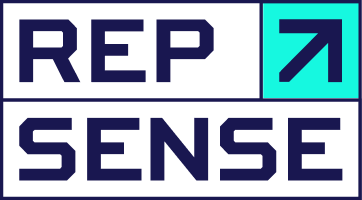4 Repsense Features That Will Help You Understand Your Brand Reputation
When we choose which new features to develop for the Repsense online reputation management tool, we use our NIIS communication management model as the blueprint. NIIS model measures not only the quantity of noise your brand makes online but also considers the quality of content.
NIIS – the new type of communications funnel
Marketing teams already have a framework similar to NIIS – it’s the marketing funnel. Using it, savvy marketers take a website visitor and give them enough information and incentives to become a customer.
NIIS model does the same. It's a funnel communications teams could use to take a person who knows nothing about the brand and slowly turn them into a brand ambassador.
NIIS Communications Funnel
How to send out a clear signal about your brand
There are four elements to the NIIS model:
Noise. The first stage of this funnel consists of the noise your brand makes online. It's all the buzz you generate with your PR efforts, organic content, social media, and advertising. It is how the general public learns that your brand is out there.
Impact. If you generate enough noise, we can start talking about its quality. Do your posts generate engagement, such as shares or comments? Is the sentiment behind your articles positive? Content in this part of the funnel helps form a deeper connection with each stakeholder.
Interest. If you have the basics covered, people will start finding your brand through related keywords. In this stage, focus on SEO and link building.
Signal. The quality of your content sends out a clear signal about your brand. Good content will ensure your stakeholders see a reason to stay with your brand and take action, while low-quality content might deter them.
While not all stakeholders need to go through the entire funnel, you must have high-quality content on each level and constantly monitor its value.
Repsense tool helps to understand how your content performs in each stage. Since there are plenty of services to analyze the Noise, such as social listening, SEO, and performance marketing tools, we started by building features that focus on tracking the Interest, Impact, and Signal stages of the NIIS funnel.
1. Brand Overview: how are you doing right now?
Most days of communications experts are filled with hundreds of tasks, including organizing events, preparing content, connecting with the media, or managing the team.
Naturally, all of these daily activities are important, but there is often not enough time to track and analyze all brand-related data. After all, there is plenty of information available, from the performance of the latest campaign to the competition activity.
The Brand Overview feature helps to get a clear and instant understanding of the brand, even if you have just a few minutes. It covers:
The Repsense Index – how much has your reputation changed since you last checked?
Total interest – how often have people searched for your brand in the past month?
Competitor overview – how are you doing compared to your competitors?
Insights – what are the low-hanging fruits that could help your reputation?
Reputation profiles – how do your investors, customers, or employees see your brand?
SERP page – what are the top results on the first page of Google?
If you have more time, you will find Interest Review, Signal Analytics, and Search Results even more insightful.
Repsense brand overview
2. Interest Review: are people interested in your brand?
The best way to stay in the spotlight is by doing the groundwork and learning what interests your potential audience.
Holding the first positions on the SERP with brand-related keywords should be a part of your daily routine. However, there are plenty of other ways to get discovered – from writing articles relevant to the industry to backlink building to getting featured on Google News or Google Features. That's why it's essential to create content keeping in mind the topics that interest your potential audience in all markets.
Repsense Interest Review feature covers:
Share of search – what is your share of search online, compared to the competitors?
Interest – what is the estimated search volume about your company on Google?
Discoverability – how well are your brand keywords represented in industry-related searches?
Mentions – what are the main keywords associated with your brand?
Google news – what is the impact and quality of the content on Google News, and in which websites mention your brand most often?
Repsense Interest Review
3. Signal Analytics: how do different stakeholders see your brand?
Often, communication experts would make a mistake thinking that people search for your brand by entering the brand title into the search box. That's not how things work.
A potential employee would search for open positions or try to glimpse into the company culture through Glassdoor. A customer will check for product reviews. A future investor might be interested in seeing your CEO's insights positively presented in the media.
So, Signal analytics help to see your brand from all of these different perspectives, considering the following:
Factors – what is the information quality, sentiment, diversity of information, availability on Google Features, or access to your content in different languages?
SERP insights – how can you improve the first page of Google when someone checks your brand-related keywords?
Industry – how strong is the signal you send, and does it stand out among your competitors?
Repsense Signal Analytics
4. Search Results: what can people see when they search for you?
And finally, sometimes a detailed view is all you need to make the right choices with your next communications program. We've created the Search Results feature as a closeup of what exactly takes up the top of your search result page.
As always, it is possible to check each of these categories through the lens of the CEO, employee, investor, the general public, or someone hearing about your brand for the first time.
The section covers the following:
Search – which SERP pages are visible to different stakeholders?
Hero content – what high-value content and high-volume searches are seen by people who check out your brand?
Reviews – what is the overall sentiment in your brand reviews, and how could you fix it?
How can you utilize Repsense features for your business?
Start tracking your online brand reputation and get an exact score that helps to inform your next decision. Shape the brand narrative using 1000s of datapoints and analyze it using our artificial intelligence model.
Repsense platform is ready with a comprehensive brand view – and has plenty of actionable insights to use right away. Book a demo and explore how can reputation tracking boost your brand visibility:





